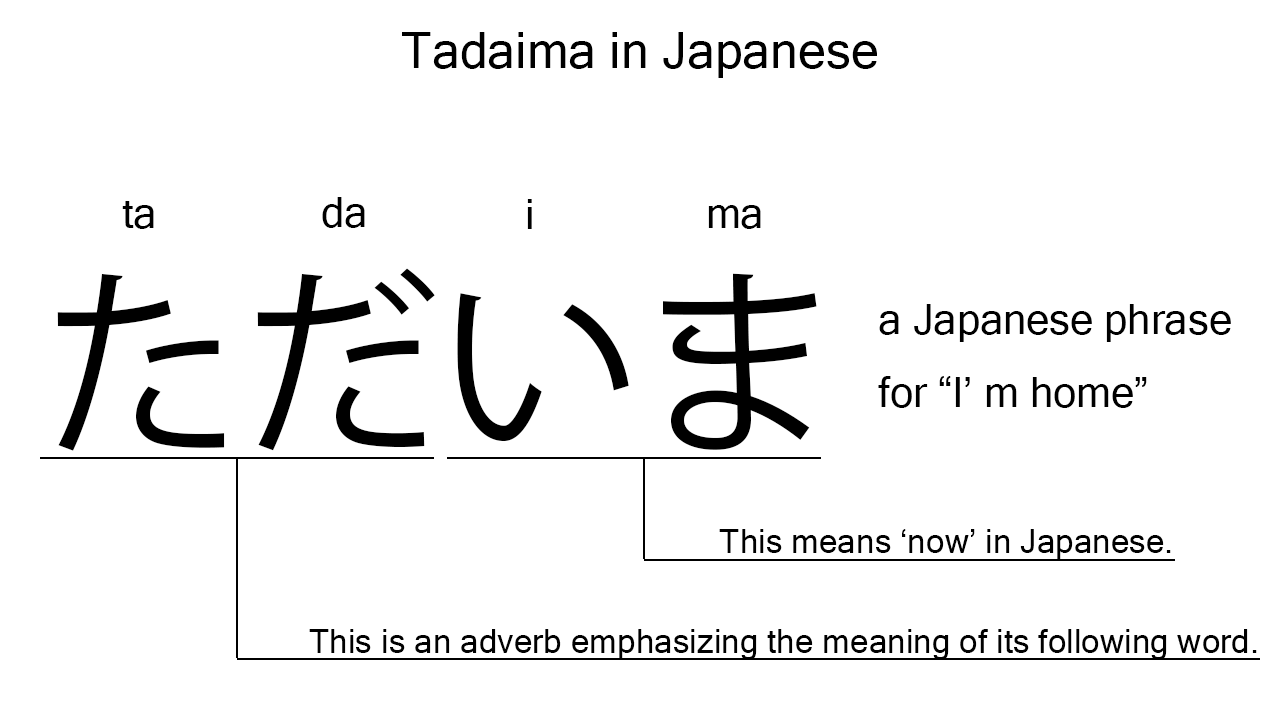What does “tadaima” mean in Japanese?
A lot of Japanese learners understand that “tadaima” is the Japanese phrase for ‘I’m home’. This understanding is correct. Native speakers often say “tadaima” to mean ‘I’m home’ in Japanese. Interestingly, however, it literally means ‘just now’ and does not contain any word referring to “I” or “home”. In this blog post, therefore, I will explain this phrase in detail together with its original version. And also, I will explain how to use it through an example sentence. My explanations would help Japanese learners understand “tadaima” more clearly. Then, let’s get started!
Contents
- Definition and meaning of “tadaima”
- What does “tadaima” literally mean in Japanese?
- How can “just now” be “I’m home” in Japanese?
- Summary
Definition and meaning of “tadaima”
Let me start with the definition and meaning of “tadaima”.
- tadaima – ただいま : a phrase meaning ‘I’m home’ in Japanese.
Japanese native speakers use this phrase to announce their arrivals at home. So, this can work in more or less the same way as the English phrase, “I’m home”, does.
It’s also worth mentioning here that native speakers occasionally use this phrase to say “just now” in Japanese. Interestingly, this is widely considered as the original usage of the phrase. To understand this point more clearly, let me explain the grammatical components of “tadaima” in detail, one by one.
What does “tadaima” literally mean in Japanese?
“Tadaima” consists of the following two components:
- tada – ただ : an adverb used to emphasize the meaning of its following word.
- ima – いま : a noun meaning ‘now’ in Japanese. This can be written in kanji as “今”, but is normally written in hiragana in the phrase.
These two components tell us that “tadaima” literally means ‘just now’ in Japanese. So, there is no wonder that native speakers occasionally use the phrase to say “just now” in Japanese.

When we meet new Japanese phrases, we should check their components in detail to understand their meanings clearly and deeply. In many cases, grammatical components tell us a lot about the meanings of the phrases they form. Actually, here, we could get the better understanding of “tadaima” through the detailed check above.
So far, I’ve explained the definition and meaning of “tadaima” together with its grammatical components. Next, the question naturally arises: how can “just now” be “I’m home” in Japanese? Let me answer this question.
How can “just now” be “I’m home” in Japanese?
Japanese native speakers are very lazy, so often shorten daily-used phrases. They made “tadaima” from its original version, “tadaima kaerimashita”. To understand the original meaning more clearly, let me explain three new components as follows:
- kaeri – 帰り (かえり) : one conjugation of the verb, “kaeru”, which means ‘to come back’ or ‘to come home’ in Japanese.
- mashi – まし : one conjugation of the auxiliary verb, “masu”, which is used after a verb to make it polite.
- ta – た : an auxiliary verb used after a verb, adjective, or auxiliary verb to make its past tense form.
From these three new components and two already explained, we can understand that “tadaima kaerimashita” is the polite phrase which literally means ‘just now came home’ in Japanese. Again, but Japanese native speakers are very lazy. They don’t want to use the long version to announce their arrivals at home. Its first two components are sufficient for them. This is how the phrase literally meaning ‘just now’ can work widely to mean ‘I’m home’ in Japanese.
Then, let me explain how to use “tadaima” through the example sentence below.
Example: how to say “I’m home” in Japanese
「tadaima」 to kanojo ga it ta – 「ただいま」と彼女が言った (「ただいま」とかのじょがいった)
“I’m home,” she said.
Below are the new words used in the example sentence.
- to – と : a case particle working as a quote marker. In the example, this works after the clause to indicate what “kanojo” said.
- kanojo – 彼女 (かのじょ) : a pronoun meaning ‘she’ in Japanese.
- ga – が : a case particle used to make the subject word or the object word in a sentence. In the example, this is used after “kanojo” to make the subject in the sentence.
- it – 言っ (いっ) : one conjugation of the verb, “iu“, which means ‘to say’ in Japanese. In the example, it has been conjugated for the better connection with its following word.
- ta – た : the same as used in “kaerimashita”. In this example, this is used after “it” to make its past tense form, “it ta”.
This is a typical usage of “tadaima”. When we want to say “I’m home” in Japanese, this phrase is always a very good option.
Summary
In this blog post, I’ve explained the definition and meaning of “tadaima” in detail together with its original version. And also, I’ve explained how to use it through the example sentence. Let me summarize them as follows.
- tadaima – ただいま : a phrase meaning ‘I’m home’ in Japanese. Japanese native speakers use this phrase to announce their arrivals at home. So, this can work in more or less the same way as the English phrase, “I’m home”, does.
Hope my explanations are understandable and helpful for Japanese learners.